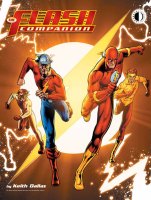Just as singers enjoy covering other people’s songs from time to time, comic book artists occasionally remake older covers. Sometimes it’s the artist’s idea, and sometimes the editor suggests it. Often the new artist will add an “after so-and-so” note to his signature, just to acknowledge the original.
Here is a gallery of cover homages I’ve found among the various Flash series.
| Theme | Original | Remake |
|---|---|---|
| Introducing the Flash | Flash Comics #1 | Impulse #84 |
| Speed Kills | Flash Comics #16 | Flash v.2 #106 |
| Showcase | Showcase #4 | Flash: The Return of Barry Allen (TPB), Flash: Rebirth #2 |
| Master of Mirrors | Flash v.1 #105 | Flash v.2 #105 |
| Flash of Two Worlds | Flash v.1 #123 | Flash v.2 #123, Flash v.1 #147, Impulse #70, Flash: Rebirth #5 |
| Reverse-Flash | Flash v.1 #139 | Flash v.3 #7 |
| Tricycle Pursuit | Flash v.1 #152 | Impulse #30 |
| Gauntlet of Super-Villains | Flash v.1 #155 | Flash v.2 #220, Flash v.1 #243 |
| Double Jeopardy | Flash v.1 #140 | Flash v.1 #299, Flash v.1 #312, Flash v.2 #221 |
| Stop! | Flash v.1 #163 | DC Comics Presents: The Flash |
| Superman vs. the Flash | Superman #199 | Adventures of Superman #463, Action Comics #892 |
| Rogues Triumphant! | Flash v.1 #174 | Secret Origins #41, Countdown Promotion |
| Samuroid | Flash v.1 #181 | Brave and the Bold #13 |
| The Most Tragic Day | Flash v.1 #184 | Flash v.2 #76, Flash v.1 #340 |
| Blue Faces | Crisis on Infinite Earths#5 | Flash v.2 #225 |
| Final Fate | Crisis on Infinite Earths#8 | Flash: TFMA #13 |
| Racing Jets | Flash v.2 #1 | Legends of the DC Universe #15 |
| Blurring Fists | Flash v.2 #8 | Flash v.2 #114 |
| Catching Bullets | Flash v.2 #48 | Flash v.2 #115 |
| Secret Files | Flash Secret Files #1 & #2 | |
| Out of the Way | Impulse #46 | Impulse #58 |
| Full Coverage | Flash #181 | Impulse #81 |
| Pulling On Boots | Flash: Rebirth #1 | Blackest Night: The Flash #1 |
Introducing the Flash
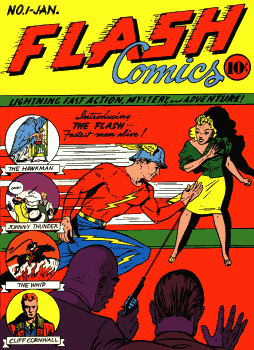 Flash Comics #1 (Jan. 1940) Sheldon Moldoff |
 Impulse #84 (May 2002) Carlo Barberi & Wayne Faucher |
The very first appearance of the Flash, Flash Comics #1 took 62 years to be redrawn. The occasion? A significant change for Impulse. With Max Mercury missing, Jay Garrick would become Bart’s guardian in this issue. Unfortunately, even the original Flash could not save the series, and it was canceled just five issues later, leaving Max’s disappearance explained, but not resolved.
Speed Kills
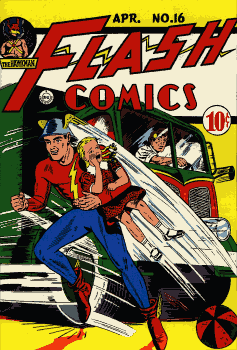 Flash Comics #16 (Apr. 1941) Sheldon Moldoff or Hal Sharp |
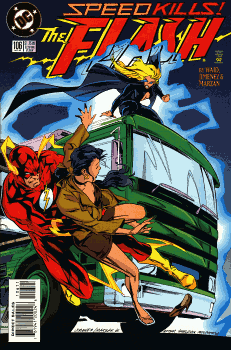 Flash v.2 #106 (Oct. 1996) Oscar Jimenez & José Marzan, Jr. |
Until I pulled out Impulse #84, this was the earliest Flash cover I could find that had been redone. The original was just a “hero in action” cover, and had nothing to do with the story. The later cover does come from the story, in which Magenta hijacks a truck and grabs Linda as a hostage... though I have no idea why they chose to remake this particular cover. On that cover credit: The first cover is (typically) unsigned, but The Golden Age Flash Archives #1 credits it to Hal Sharp. The signature on the remake, however, lists “After Sheldon Moldoff,” who did do a number of the classic Jay Garrick covers.
Showcase
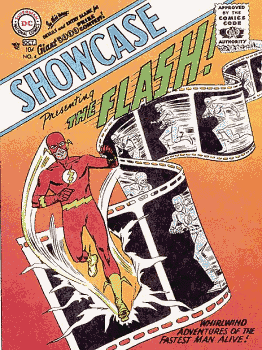 Showcase #4 (Oct. 1956) Carmine Infantino & Joe Kubert |
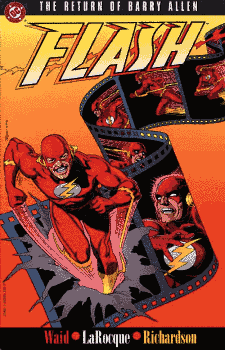 The Return of Barry Allen TPB (1996) Brian Bolland |
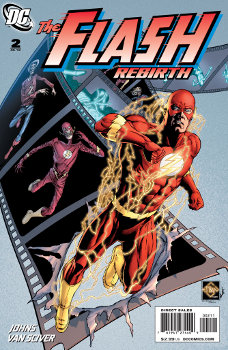
Flash: Rebirth #2 (July 2009)
Ethan Van Sciver
Showcase #4 was the first appearance of the Silver-Age Flash, the classic cover featuring the hero bursting out of a strip of (presumably high-speed) film. “The Return of Barry Allen” featured the hero’s apparent return, but he wasn’t quite right. When it was collected as a book, DC chose to revisit the cover that introduced Barry... with a sinister twist.
Flash: Rebirth features Barry’s actual return, but once again, something’s wrong, and DC put yet another twist on the classic. This time the Flashes on film are the corpses of other speedsters (Wally West, Jay Garrick, Liberty Belle/Jesse Chambers, and Kid Flash/Bart Allen are all recognizable), while a glowing skeleton runs along the reverse side of the film.
Master of Mirrors
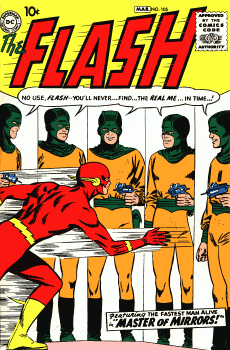 Flash v.1 #105 (Mar. 1959) Carmine Infantino & Joe Giella |
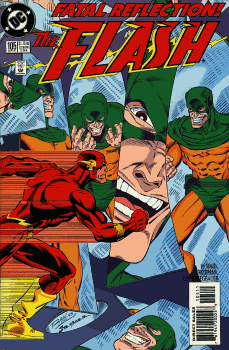 Flash v.2 #105 (Sep. 1995) Ron Lim & Mark Stegbauer |
When the Silver-Age Flash proved popular enough to get his own series, DC picked up the numbering where the previous series had left off: #105. The inaugural villain was the Mirror Master, in his first appearance. When the modern series reached the #105 milestone, they celebrated with the return of the new Mirror Master.
(Thanks to “Kings” for pointing this one out!)
Flash of Two Worlds
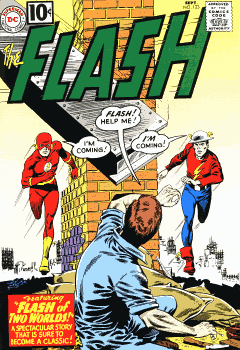 Flash v.1 #123 (Sep. 1961) Carmine Infantino & Murphy Anderson* |
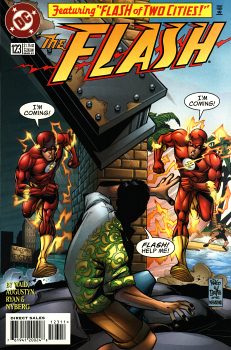 Flash v.2 #123 (Mar. 1997) Mike Wieringo & John Dell |
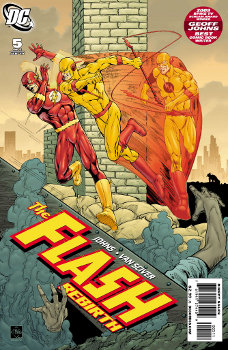 Flash: Rebirth #5 (Jan 2010) Ethan Van Sciver |
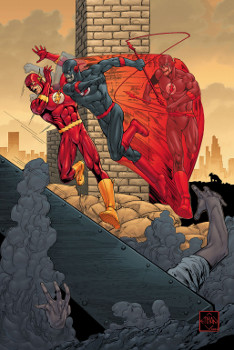 Flash: Rebirth #5 (Previewed) (Jan 2010) Ethan Van Sciver |
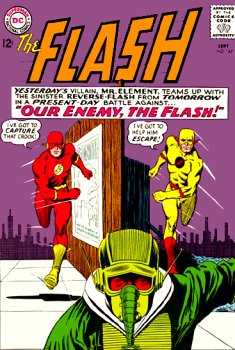 Flash v.1 #147 (Sep. 1964) Carmine Infantino & Murphy Anderson |
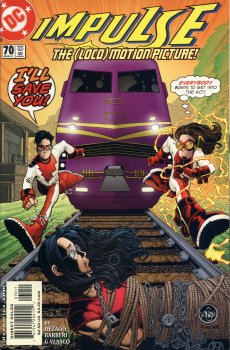 Impulse #70 (Mar. 2001) Ethan van Sciver & Wayne Faucher |
Flash #123 was an all-around classic. It featured the first meeting between DC’s Silver-Age characters and its Golden-Age characters, paving the way for a new generation of readers to meet the JSA. It also established the multiple-earths framework that DC would use to keep groups of characters separate until Crisis on Infinite Earths, nearly 25 years later. In the original, Barry Allen crossed-over to Earth-2 and convinced Jay Garrick to come out of retirement to battle the Fiddler, the Thinker, and the Shade. (This has been adjusted for post-Crisis continuity.)
According to Carmine Infantino, this story came about as a result of an attempt to stump Julius Schwartz. Infantino kept drawing covers with ever-more-bizarre cliffhangers, and Schwartz kept coming up with stories to go with them. Finally, he drew this image of the Flash and the Golden Age Flash running to save the same guy, handed it to the editor, and said, “There! Top that!”
As the next Flash series approached issue #123, they decided to honor it with a new storyline, “Flash of Two Cities,” in which Wally West had to split his time between Keystone City, Kansas, and Santa Marta, California. This story also led to a reintroduction: the major Rogues had been killed the previous year in Underworld Unleashed, and writer Mark Waid had come to realize it had been a big mistake. The last page of this issue featured the first hints of the Rogues’ return. Mike Wieringo reinterpreted the classic cover for the new story.
Flash: Rebirth #5 takes the original scene and alters it: the Reverse Flash has ambushed Jay Garrick (you can see his silhouette in the background) and taken his place, running past the wall to attack Barry. Meanwhile, the poor construction worker has been crushed by the falling girder. To avoid revealing Zoom’s involvement, DC solicited the book with an altered cover, showing the Black Flash instead of Professor Zoom.
Subtle Approach
This cover has also been referenced more subtly. First by Infantino himself in Flash #147, then later by Ethan van Sciver and Wayne Faucher for Impulse #70. The basic layout is the same: a vertical divider, someone in peril at the base of the cover, and two speedsters running toward the victim. With the Flash cover, the speedsters are the Flash and the Reverse-Flash, both pursuing Mr. Element. Interestingly, the first three Reverse-Flash covers all featured a split-cover design, as described at Dial B for Blog. (Thanks to Omar Karindu for pointing out the Reverse-Flash cover.)
The Impulse cover features Impulse and one of Bart’s friends dressed in an Impulse costume, as the teens shoot a movie about their town’s resident speedster, unaware that their friend is the hero himself. Van Sciver and Faucher’s joint signature includes the remark, “With a ‘howdoyado’ to Infantino.” (Thanks to Veronica Dymond for pointing out the Impulse cover)
Beyond the Flash
The cover has also been referenced many times in other series. Some examples include:
- The Silver Age #1 (2000), first issue of a “fifth week” event.
- Tangent: Superman’s Reign vol.1 (originally a promotional piece from 2007, when the series was going to be called Tangent: Global Degree).
- Lobo Convention Special (1993, with “Thrash of Two Worlds”)
- Action Comics #445 (1975)
- Son of Ambush Bug #3 (1986)
- DHP #67 (1992)
- Sonic the Hedgehog #9 (1994)
*The Flash Archives vol.3 incorrectly credits interior inker Joe Giella with the cover. (Thanks to Bob Bailey for the correction.)
Double Jeopardy
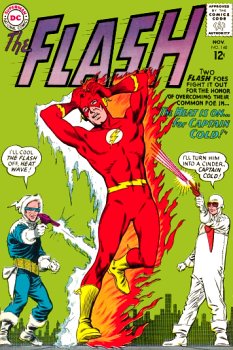 Flash v.1 #140 (Nov. 1963) Carmine Infantino & Murphy Anderson |
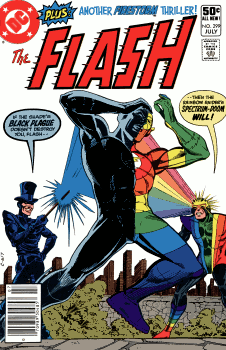 Flash v.1 #299 (July 1981) Carmine Infantino & Dick Giordano |
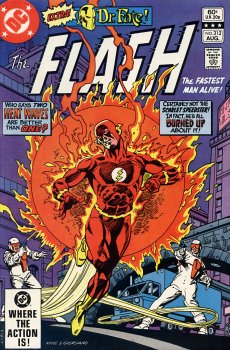 Flash v.1 #312 (Aug. 1982) Gil Kane & Dick Giordano |
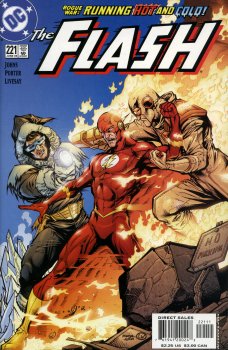 Flash v.2 #221 (June 2005) Howard Porter & Livesay |
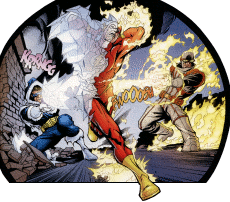
Flash v.2 #221 interior (June 2005)
Howard Porter & Livesay
Flash #140 introduced Heat Wave, a counterpart to the long-established Captain Cold. They were rivals from the beginning, fighting over the affections of a TV personality “Dream Girl.” Of course, the way to her heart was through the Flash....
The image of the Flash being hit from either side by opposing powers returned in Flash #299, in which the darkness-powered Shade teamed up with the Flash against the color-themed Rainbow Raider. Flash #312 brought it back with a twist: instead of two opposite weapons, the Flash was hit by two identical blasts, as a pretender took on the role of a second Heat Wave.
Flash v.2 #221 was the second part of “Rogue War,” the culmination of three years of storylines (see also the Gauntlet of Super-Villains and Blue Faces covers). The Rogues Gallery goes up against a team of former Rogues turned hero, with Captain Cold and Heat Wave on opposite sides. The cover takes a variation on the original design, with the two rogues more intent on stopping each other than on the Flash. An interior panel features a more direct reference to the classic cover.
Reverse-Flash
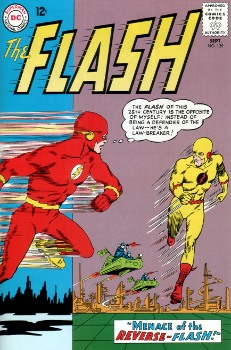 Flash v.1 #139 (May 1965) Carmine Infantino & Murphy Anderson |
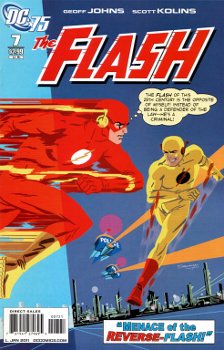 Flash v.3 #7 (Jan. 2011) Darwyn Cooke |
The original cover, one of several using a split-panel layout, features the first-ever appearance of Professor Zoom, the Reverse-Flash. In 2010, DC Comics ran a series of variant covers re-imagining classics for their 75th anniversary. Among them: this version by Darwyn Cooke (DC: New Frontier), whose style fits the era of the original comics quite well. DC missed an opportunity, though: this issue focuses on Captain Boomerang. If they’d waited one month, it could have gone on “The Secret Origin of the Reverse-Flash.”
Tricycle Pursuit
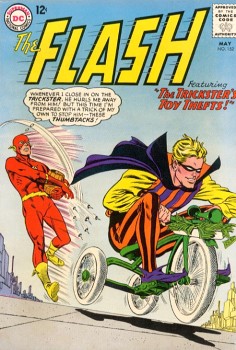 Flash v.1 #152 (May 1965) Carmine Infantino & Murphy Anderson |
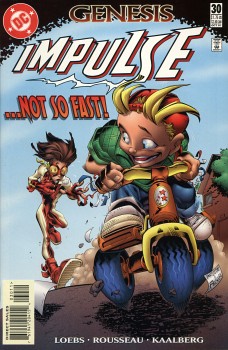 Impulse #30 (Oct. 1997) Jeff Matsuda & Wayne Faucher |
Nothing connects these two stories save the fact that speed alone is not the solution. In the first, the Trickster repeatedly distracts the Flash with disasters in order to make his getaway. In the second, a tie-in to the Genesis crossover event, super-powers become unreliable. Impulse loses his speed, and is shown on the cover unable to keep up with a child on a tricycle—though he finds himself usign other heroes’ powers during the story.
(Thanks to Superdickery for reminding me of this one.)
Gauntlet of Super-Villains
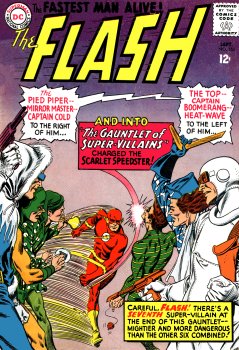 Flash v.1 #155 (Sep. 1965) Carmine Infantino & Murphy Anderson |
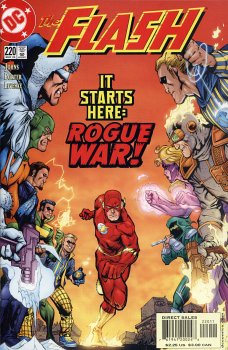 Flash v.2 #220 (May 2005) Howard Porter & Livesay |
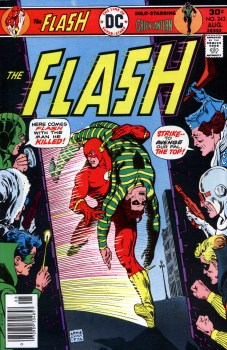
Flash v.1 #243 (Aug. 1976)
Ernie Chan (signed as Ernie Chua)
Flash v.1 #155 featured the first appearance of the Flash’s Rogues Gallery as a team. Released from prison simultaneously, they decided to work together to defeat the Flash. The cover shows the villains lined up on either side of the Flash’s path as he has to run through them. (Incidentally, DC wasn’t sure how to spell the title of the story. At least one reprint featured “The Gantlet of Super-Villains.”)
“Rogue War” began in Flash v.2 #220, pulling the trigger on three years of build-up. The war is between two groups of Rogues: one still villainous, the other a team of former Rogues turned hero—with the Flash caught in the middle. (See also the Double Jeopardy and Blue Faces covers.)
A similar cover adorns Flash v.1 #243, in which the Rogues learn of the Top’s demise. Much like in the original cover, they lie in wait on opposite sides, waiting for the Flash to enter the trap, with the Flash and the Top holding the center. (For the record, the Flash didn’t technically kill the Top, though the Top certainly blamed the hero for his death. The Top’s brain reacted badly to the Flash’s super-speed vibrations, setting up a chain reaction that killed him—but not before he set in motion plans for revenge.)
(Thanks to Logan Mo Mott or pointing out Flash v.1 #243.)
Stop!
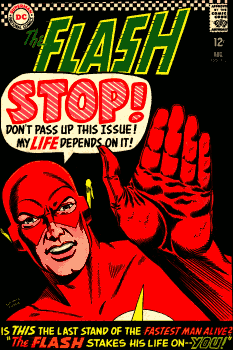 Flash v.1 #163 (Aug. 1966) Carmine Infantino & Joe Giella |
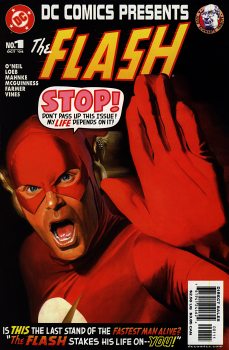 DC Comics Presents: The Flash (Oct. 2004) Alex Ross |
Editor Julius Schwartz was well known for his “concept covers.” He would have an artist do a cover, then ask the writer to come up with a story based on it. In this case, John Broome wrote about a villain removing the Flash from everyone’s memory, and, in a Peter Pan-like story, the Flash had to convince enough people to believe in him.
When Schwartz died in 2004, DC planned a commemorative series to honor the man credited with launching the Silver Age of comics. So the cover served as a springboard once again, this time for two stories. In the first, by Jeph Loeb, a bullet (needed for evidence) is found lodged in a stack of comic books (Flash #163, of course!). The second, by Dennis O’Neil, is more in line with some of the more “out-there” Silver Age stories, and involves the Flash using comic books to make people aware of his latest predicament.
Reportedly, the original cover was Julie Schwartz’s favorite cover of all time.
Superman vs. the Flash
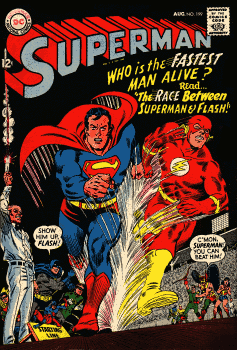 Superman #199 (Aug. 1967) Carmine Infantino & Murphy Anderson |
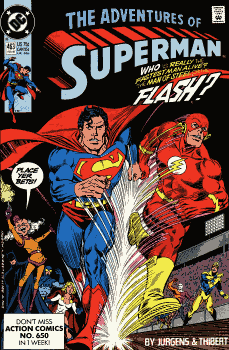 Adventures of Superman #463 (Feb. 1990) Dan Jurgens & Brett Breeding |
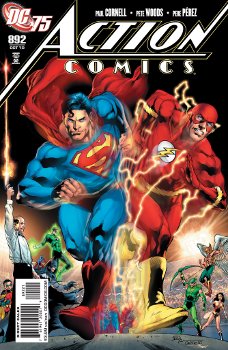
Action Comics #829 (October 2010)
Ivan Reis
Superman #199 featured the first of many races between Superman and the Flash. That race, and the first rematch, ended in a tie, but the Flash eventually won. Once Wally West stepped into the boots, the question was open again, and so a new race was set. Fittingly, the cover was an homage to the original race. (See also the Superman-Flash Races.)
For DC Comics’ 75th anniversary, the publisher commissioned a series of variant covers that referenced classic DC comics. Among those chosen was the classic race, which was used as the alternate cover for Action Comics #892 (which, as it happens, featured neither the Flash nor Superman).
(Thanks to Michael Edgecomb, Jr. for reminding me of the Action Comics #892 homage and sending me the scan.)
Rogues Triumphant!
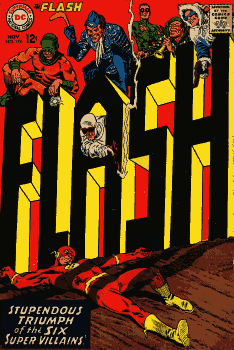 Flash v.1 #174 (Nov. 1967) Carmine Infantino & Murphy Anderson |
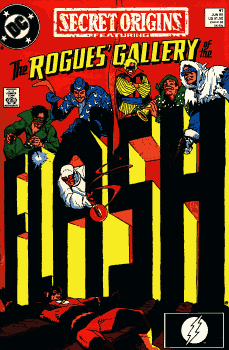 Secret Origins #41 (Jun. 1989) Mike Mignola |
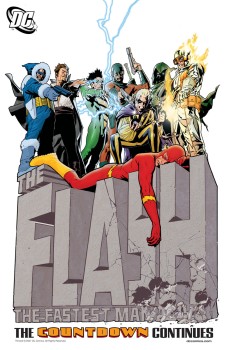
Countdown Teaser
for Flash: TFMA #13 (May 2007)
Ryan Sook
Flash #174 featured the Rogues in their second appearance as a team. Mirror Master learned how to eliminate the Flash’s speed by watching his duplicate in an alternate universe where the Flash was a villain. He broke his fellow criminals out of prison to share in the triumph, only to capture the wrong Flash in the end.
For its focus on the Rogues, this design was chosen as the source for a Secret Origins issue that told the Rogues’ stories. (Although Grodd is the main villain of the Secret Origins piece, his own origin is covered in the previous issue.)
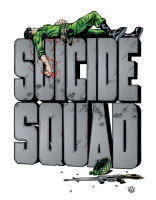
Suicide Squad v.2 #4
(Feb. 2002)
Paco Medina
A promotional piece for Flash: The Fastest Man Alive #13 (2007) combined the motif with a more recent cover, Suicide Squad #4 (2002), that series’ entry in the Full Coverage event. The weekly series Countdown had featured a gathering of the Rogues as they prepared for the crime they carried out in Flash: TFMA #11–13... a crime in which the Rogues were guided by an evil duplicate of the Flash (this time Inertia, Bart’s clone). The promotion appeared as a house ad in DC books during the week of Countdown #48, and was released online to much speculation.
As with the Flash covers, the Rogues loomed over the Flash’s lifeless body. Like the Suicide Squad piece, the hero lay on top of the rock-like letters, one arm hanging down, against a stark white background. The Sook piece became the basis for a whole series of Countdown teasers for other series, and appeared on two covers: the DC Nation Variant of Flash: TFMA #13 and Countdown Special: The Flash.
(Thanks to Doug Nasluchacz for tracking down the artist on Secret Origins #41. Thanks also to Comics Should Be Good for posting the Full Coverage collection, and reader acespot for pointing out the similarity between Suicide Squad #4 and the Countdown promo.)
Samuroid
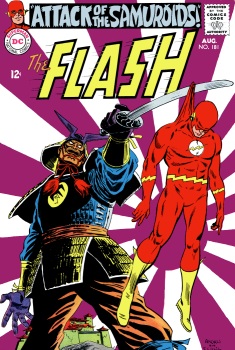 Flash v.1 #181 (Aug. 1968) Ross Andru & Mike Esposito |
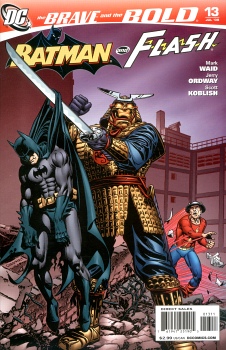 Brave and the Bold #13 (Jul. 2008) Jerry Ordway |
This one’s a bit tenuous, but both covers feature an unconscious hero hanging from the robot samurai’s sword by the back of his costume. In fact, Batman and the Flash look to be hanging in nearly the same position. Add in the fact that to the best of my knowledge, the second cover is the first appearance of the Samuroids in forty years, and it seems likely that Ordway may have deliberately invoked the earlier cover.
The Most Tragic Day
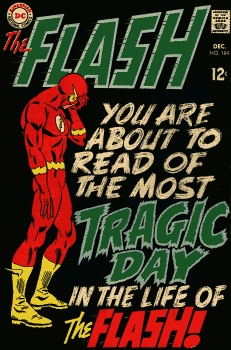 Flash v.1 #184 (Dec. 1968) Ross Andru & Mike Esposito |
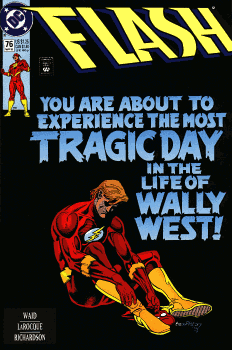 Flash v.2 #76 (May 1993) Ty Templeton |
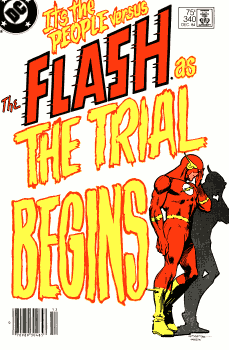
Flash v.1 #340 (Dec. 1984)
Carmine Infantino & Klaus Janson
The starkness of these covers, and the overwhelming presence of the words, is what stands out most about them. Both “Tragic Day” covers feature disasters very personal to the Flash. In the first case, Barry Allen has been convinced that he was responsible for the utter destruction of Central City and everyone he knows there. In the second (part of “The Return of Barry Allen”), Wally West has been deliberately left to die by a man he thinks is Barry. One of the interesting changes is that the second cover refers not to “The Flash” but to “Wally West,” and he appears unmasked, underscoring the real identity crisis he’s dealing with: Is he really the Flash? Has he lived up to Barry’s legacy? If even Barry wants him dead, just what is his life worth? (Also interesting: by the end of the issue, “Barry” threatens to destroy Central City.)
The cover at the right is very similar, the hero standing in almost the same position, though the background is starkly white instead of black. This issue moves the two-year story arc dealing with the death of Professor Zoom into a new phase, as the Flash’s trial begins. After years of protecting the city, years of defending the law, the Flash is now an accused criminal, his life spiralling out of control.
Blue Faces
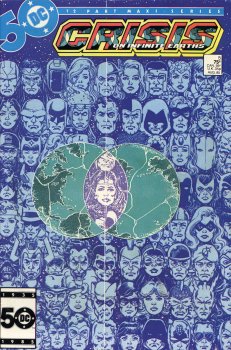 Crisis on Infinite Earths #5 (Aug. 1985) George Perez |
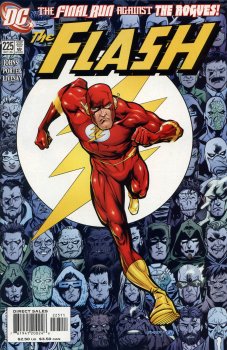 Flash v.2 #225 (Oct. 2005) Howard Porter & Livesay |
Crisis on Infinite Earths #5 is notable for being the point where the worlds of DC Multiverse began merging into a single world. At that point, the universes were still separate, but had begun overlapping, with some areas linking one world to another and one time to another. The cover featured two overlapping images of the Earth, on top a of a field of faces washed in blue, representing the heroes of Earth-1 and Earth-2.
Flash v.2 #225 was the final issue written by Geoff Johns (before he departed to write Infinite Crisis, the sequel to CoIE), and the conclusion of the epic “Rogue War” story that had been building for three years (see also the Gauntlet of Super-Villains and Double Jeopardy covers). The cover featured a similar field of blue faces, this time representing the dozens of villains who have menaced the Flash over the years. Instead of the circles of two Earths in the foreground, the Flash’s insignia takes the center spot. It’s worth noting that the issue involves time travel and an alteration of history—specifically, the critical battle with Zoom during “Blitz.”
Final Fate of the Flash
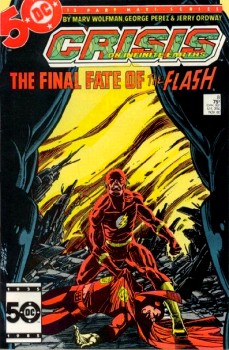 Crisis on Infinite Earths #8 (Nov. 1985) George Perez |
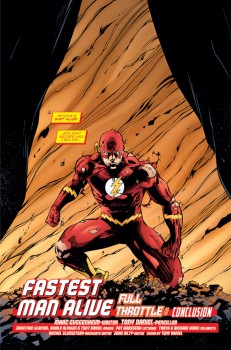 Flash: The Fastest Man Alive #13 interior (Aug. 2007) Tony Daniel & ??? |
Crisis on Infinite Earths #8 featured the death of the Silver-Age Flash, Barry Allen. This led to Wally West taking up the mantle. His death continues to resonate today with his successors, and, in the real world, among Flash fans.
The transition was echoed when Wally disappeared in Infinite Crisis, and Bart Allen stepped up for a brief career as the fourth Flash. The splash page for his final issue referred back to that classic cover.
Writer Marc Guggenheim commented on the reference in a Q&A thread at Comic Bloc:
My original plan was to have each issue be an homage to a classic Flash cover, but that idea got vetoed early on. However, I’m a sneak, hence moving the Crisis #8 homage into an interior splash pages.
Racing Jets
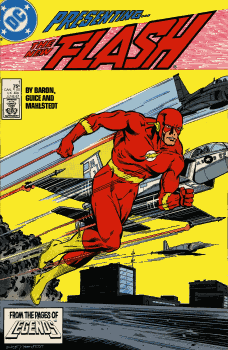 Flash v.2 #1 (Jun. 1987) Jackson Guice & Larry Mahlstedt |
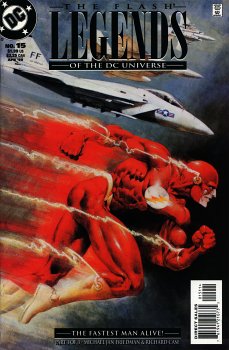 Legends of the DC Universe #15 (Apr. 1999) Carl Critchlow |
This is the first post-Crisis Flash cover to be remade—and it’s also the first post-Crisis Flash cover ever! The motif of racing fighter jets was used again for the first (and, as it turns out, only) Flash story arc of Legends of the DC Universe, a series which focused on heroes who were long-gone and on the early years of heroes who were still around.
Blurring Fists
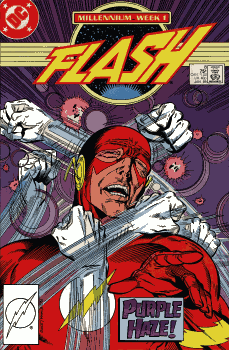 Flash v.2 #8 (Jan. 1988) Jackson Guice & Larry Mahlstedt |
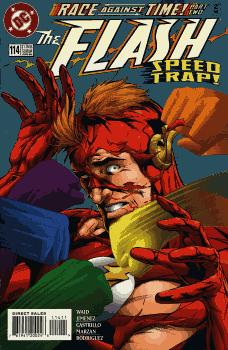 Flash v.2 #114 (Jun. 1996) Oscar Jimenez & José Marzan, Jr. |
These covers grace a pair of stories in which Wally is overwhelmed while facing off against other speedsters, and in which he deals with family matters. In Flash #8, he fights Blue Trinity to bring Red Trinity to America to save a life, and learns that his father has betrayed the human race. At one point Wally is beaten, and watches the two trinities battle each other—at that speed, a literal “purple haze.”
Flash #114 explores similar themes. Part of Race Against Time, Wally’s half of the issue focuses on his arrival in the 30th Century, where he encounters Barry’s children (his cousins), the Tornado Twins. Each is jealous of the other—Wally because they’re actually related to Barry, Don and Dawn because Wally actually knew their father.
Catching Bullets
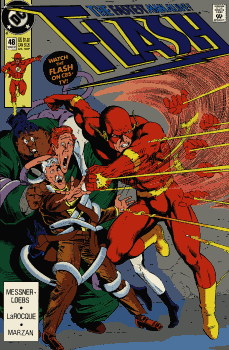 Flash v.2 #48 (Mar. 1991) Greg LaRocque & José Marzan, Jr. |
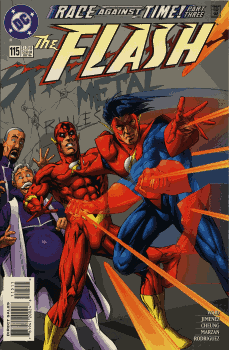 Flash v.2 #115 (Jul. 1996) Oscar Jimenez & José Marzan, Jr. |
There doesn’t seem to be a relation between these two issues, but the layout on the second cover is so similar to the first that it’s almost certainly intentional.
Secret Files
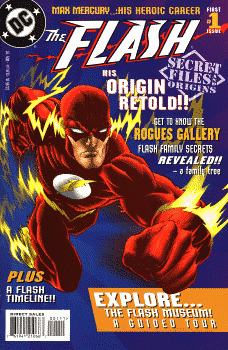 Flash Secret Files #1 (Nov. 1997) Steve Lightle |
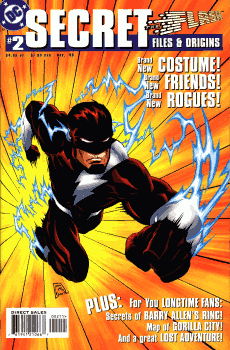 Flash Secret Files #2 (Nov. 1999) Steve Lightle |
When DC started releasing a series of “Secret Files” books in the late 1990s, Steve Lightle was the cover artist on the Flash. Naturally, he was chosen to do the cover for The Flash Secret Files. Two years later, the book had undergone major changes, particularly with the introduction of a mysterious new Dark Flash, and a new Flash Secret Files was planned. Lightle was again chosen to do the cover, and figured, why not use the same design with the new Flash? In a whimsical mood, he even added “after me!” to the signature.
Out of the Way
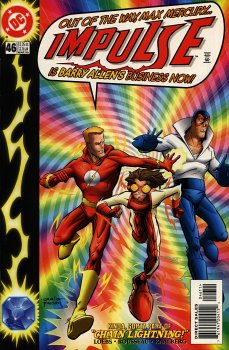 Impulse #46 (Mar. 1999) Craig Rousseau & Wayne Faucher |
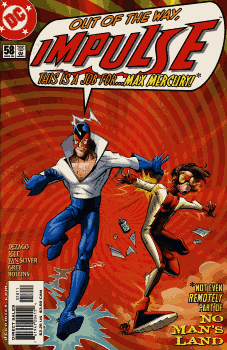 Impulse #58 (Mar. 2000) Craig Rousseau & Wayne Faucher |
To date, this is the only Impulse cover to be redone. The original takes place early in Chain Lightning (see the Cobalt Blue Legacy), and Impulse has been asked to read Barry Allen’s biography before they begin. His mind wanders, of course, and he imagines his life if Barry were his guardian, instead of Max... filtered through Bart’s own ideals, of course!
The second book is a Max Mercury solo story, focusing on a typical day in his life. It also features a flashback story to early in Max’s career. The layout, swirly background, positions, and the giant word balloon all match. There’s even a dig at the not-quite-crossover aspect with the “Not even remotely part of No Man’s Land” comment.
Full Coverage
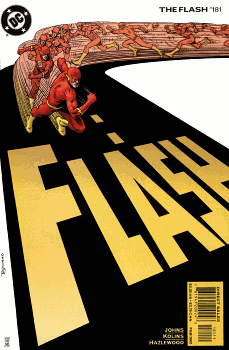 Flash v.2 #181 (Feb. 2002) Brian Bolland |
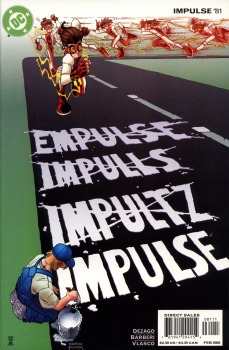 Impulse #81 (Feb. 2002) Carlo Barberi & Wayne Faucher |
This isn’t properly an homage, since these covers were done simultaneously. During this month, DC ran an event called “Full Coverage.” The idea was that the normal logos would not appear on the cover, and instead the title would be worked into the cover artwork. The teams for Flash and Impulse decided to build on the same design, with a road curving into the distance, the speedster running down the road toward the front, and the title written as a sign on the street. Naturally, Impulse took a slightly more humorous approach.
The secondary purpose of this event was to make each book accessible to new readers. Impulse #81 told a self-contained story about a filmmaker convinced he was Captain Saturn. Flash #181 mainly told the story of Fallout, but was riddled with subplots, a nasty cliffhanger, and the revelation of Plunder’s identity.
Pulling on Boots
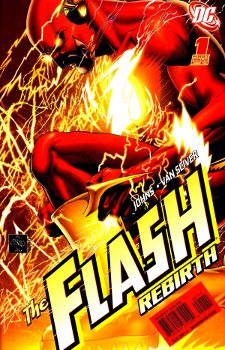 Flash: Rebirth #1 (June 2009) Ethan van Sciver |
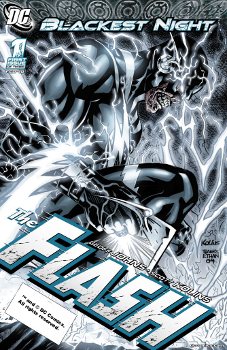 Blackest Night: The Flash #1 (Feb. 2010) Scott Kolins |
2009 was a year of transition for the Flash. For the first time in decades, there was no ongoing Flash comic book, but there were two miniseries: Flash: Rebirth re-established Barry Allen as the premiere Flash of the DC Universe, and led directly into Blackest Night: The Flash at the end of the year, and from there into the new, ongoing series.
Ethan Van Sciver’s cover for Flash: Rebirth started out as a teaser poster for the event, released when it was announced at Comic-Con International 2008. By the time the series launched, it was so well-known that it was the obvious choice for the first cover. When Blackest Night came around, one of the elements of the story was the return of the Reverse-Flash. Scott Kolins returned to the image, presenting the undead Black Lantern Professor Zoom in the same pose, only...reversed.
Text by Kelson Vibber. Do not copy without permission.